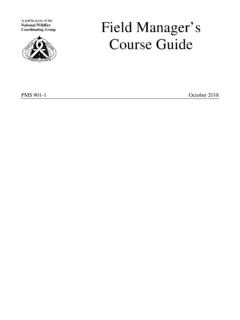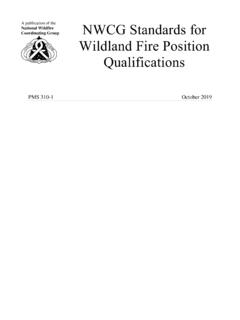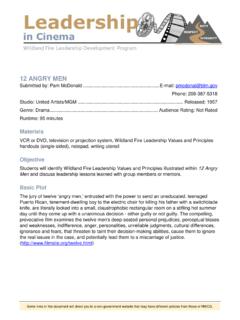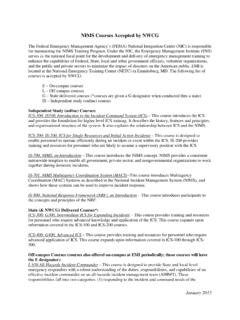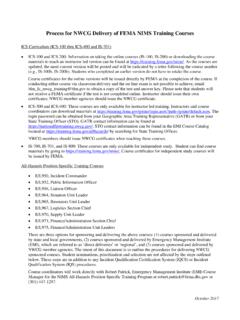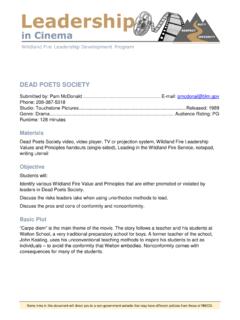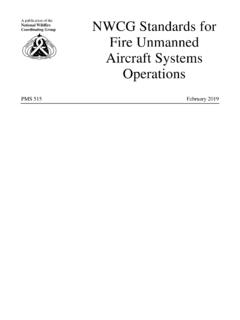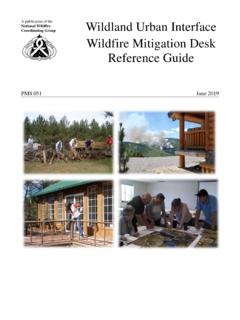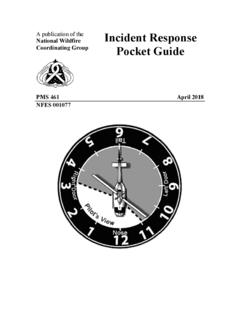Transcription of Extreme Ownership by Jocko Willink and Leif Babin
1 Some links in this document will direct you to a non-government website that may have different policies from those of NWCG. Extreme Ownership by Jocko Willink and Leif Babin Why Read Extreme Ownership ? Leadership is simple, not easy. Likewise, leadership is both an art and a science. There are no exact answers or specific formulas to follow in every case. No book can tell a leader exactly how to lead in every situation. But this book provides a sounding board for difficult decisions, a frame of reference to use for guidance when faced with tough leadership dilemmas. While the specifics of any particular situation may vary and the characters slightly differ, the principles remain the same and can be applied, either directly or indirectly, to overcome any leadership challenge that might arise.
2 Extreme Ownership is a book about a set of leadership principles learned, honed, and perfected in a time of war by a small group of Navy SEALs. These leadership principles, while martial in their development, are easily transferred outside of the military setting to the wildland fire environment. If you read only one book on leadership this year, this is the one to choose. Using parallel examples of how each concept or principle was applied in combat and in a business setting, the authors demonstrate and model their leadership principles for the reader. There are several videos on the book available online. Find some of them at the links below, or by using an internet search engine. Author Overview (8 minutes): Philosopher s Notes (14 minutes): For more leadership ideas and to dig deeper, check out the Wildland Fire Leadership Development Program (WFLDP) blog, Facebook page, Professional Reading Program, and more at the links below: Blog: Facebook: Professional Reading Program: Main WFLDP page: WFLDP Professional Reading Program Extreme Ownership 2 of 3 Extreme Ownership Discussion Questions Chapter One: Extreme Ownership What does the phrase Extreme Ownership mean to you?
3 What obstacles are there to taking Ownership of failures and mistakes in your organization and situation? How do you go about looking for the real, unbiased truth in your leadership situation? What are some tools we use in the fire service to learn from our failures, mistakes, and close calls? Chapter Two: No Bad Teams, Only Bad Leaders Do you agree or disagree with the conclusions the authors reach about teams? Have you seen good teams with bad leaders? How about bad teams with good leaders? Do you think bad teams exist? Why or why not? What do you think about the idea of it s not what you preach, but what you tolerate? Chapter Three: Believe If you re a follower, how can you prompt a leader to help you figure out the why of a task or assignment?
4 If you re a leader, how can you check to ensure you ve successfully explained the why to your followers? How is it courageous to ask why? What are the benefits of asking why? What are the drawback of not asking? Chapter Four: Check the Ego What are some ways you ve seen ego become a problem in you experience? What are some ways you can check the ego in your organization? How does controlling ego fit into the concept of Extreme Ownership ? Chapter Five: Cover and Move What are some situations where you ve had to choose the least bad option? What are some drawbacks of not coordinating with those around you in the fireline setting? Have you seen situations where teams didn t cover and move in your organization? How would try to improve those situations after reading this chapter?
5 Chapter Six: Simple What are some tools fireline leaders can use to keep things simple? How can keeping things simple allow us to more effectively deal with complexity? How do you keep things simple as technology, interagency operations, the wildland-urban interface, and policies/regulations seem to continuously make things more complex? Chapter Seven: Prioritize and Execute How do you personally set priorities in the field ? How can you ensure that you re tracking the right priorities in a high-stress, time-critical situation? What are some examples of setting priorities and executing in a wildland fire setting? WFLDP Professional Reading Program Extreme Ownership 3 of 3 Chapter Eight: Decentralized Command What are some ways we can push decision-making down to frontline leaders?
6 What about frontline followers? How can decentralized command work on your crew or in your organization? Why is trust important in this setting, for leaders and followers both? How does simplicity in Leader s Intent apply to decentralized command? Chapter Nine: Plan How do the planning principles in the book apply in wildland fire? Why is it important to incorporate Leader s (or Commander s) Intent in planning, even if it s a rapid plan? What do you think of the leader s checklist? Do you see similarities to the planning process in your organization? Chapter Ten: Leading Up and Down the Chain of Command How can you make sure you are communicating the bigger picture to your folks in a clear, concise, and simple way? Why is leading up the chain just as important as leading down the chain?
7 What do you think about the three major factors to be aware of when leading up and down the chain? Chapter Eleven: Decisiveness and Uncertainty How do you make decisions in uncertain, dynamic situations? What are some traps of being indecisive? Can you train to be better at rapid decision making. Chapter Twelve: discipline equals freedom The Dichotomy of Leadership What did you think after reading this chapter? How can discipline equal freedom in your life, personally and professionally? What do you think about the dichotomy of leadership?
